

joveria
Narrative mode. Ren - Peoples Building - Shanghai, China. Urban Aqualoop by Work Architecture Company - Modern Architecture and Home Interior Design Ideas on Cumbu.Com. Lawrence Halprin: Auditorium Forecourt Fountain (Ira Keller), Portland. Landscape Architecture Magazine has a huge 18-page spread on Lawrence Halprin (1916-2009) in the February 2010 issue.

It is a great article and you should take a look at it. For those of you who don’t know the work of Lawrence Halprin, I wanted to share my favorite Halprin project, the Auditorium Forecourt Fountain in Portland. The project is not over 40 years old but it remains one of the most important and well loved modern water features in America. Travel, art, landscape + water features. OFF Architecture’s Bering Strait Project Allows Views at Arctic Marine Fauna.
In June, Bustler published the winning entries of the Bering Strait Project competition that seeks to connect the short stretch of Arctic Ocean between Russia and the United States via a bridge or a tunnel.

Here is the proposal by Paris-based OFF Architecture (Team comprised of Manal Rachdi, Tanguy Vermet, Mathieu Michel, Takanao Todo, and Lily Nourmansouri) that won the 2nd Prize in the Professional Category: Click above image to enlargeSite Plan Zoom Out The project does not simply concern itself with the construction of a commercial or railway link, nor a bridge connecting one continent to another. Two Feet High and Rising: On Optimism, Speculation and Oysters. Critique: Mimi Zeiger Rising Currents, March 24 – October 11, 2010.
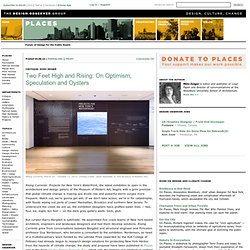
[Image credit: Jason Mandella. © The Museum of Modern Art] Rising Currents: Projects for New York’s Waterfront, the latest exhibition to open in the architecture and design gallery of the Museum of Modern Art, begins with a grim premise: that global climate change is making sea levels rise and powerful storm surges more frequent. Watch out, we’re gonna get wet. Land Art Generator Initiative. Image by HWKN The winner of the 2012 MoMA PS1 Young Architect’s Program is a public artwork that also cleans the air of pollutants via nanoparticles.

It’s another great example of solution-based artwork, or artwork that is moving beyond formative and didactic expressions and into the realm of infrastructure art. In this case, the artwork is serving the useful function of air purification, claiming a capacity equal to the removal of 260 cars from the roads. The piece will be using energy to power its multimedia interaction, so overall it is not an example of net zero energy art. But it does offset its footprint somewhat with this technological innovation. From HWKN: Wendy does not play the typical architecture game of ecological apology – instead she is pro-active.
Hopefully the titania nanoparticle spray does not have any downside ecological effects in its complete life cycle. Ryan panos · Preserving the Erased: Didactic Architecture via... History Of Storytelling – How Did Storytelling Begin? History Of Storytelling Today, stories are an intrinsic part of our societies and culture.
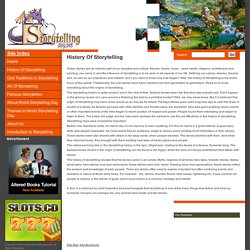
Narrative. A narrative (or play) is any account of connected events, presented to a reader or listener in a sequence of written or spoken words, or in a sequence of (moving) pictures.[1] Narrative and human nature[edit] Owen Flanagan of Duke University, a leading consciousness researcher, writes that "Evidence strongly suggests that humans in all cultures come to cast their own identity in some sort of narrative form.
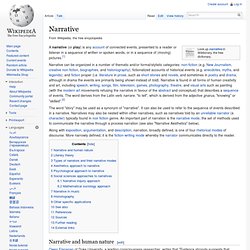
We are inveterate storytellers. Architecture theory since 1968 - K. Michael Hays. Storytelling. Historical perspective[edit] A very fine par dated 1938 A.D.

The epic of Pabuji is an oral epic in the Rajasthani language that tells of the deeds of the folk hero-deity Pabuji, who lived in the 14th century. Narrative structure. Narrative structure, a literary element, is generally described as the structural framework that underlies the order and manner in which a narrative is presented to a reader, listener, or viewer.
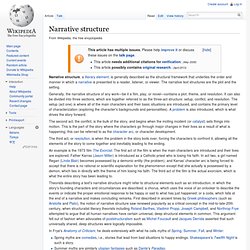
The narrative text structures are the plot and the setting. Generally, the narrative structure of any work—be it a film, play, or novel—contains a plot, theme, and resolution. It can also be divided into three sections, which are together referred to as the three-act structure: setup, conflict, and resolution. The setup (act one) is where all of the main characters and their basic situations are introduced, and contains the primary level of characterization (exploring the character's backgrounds and personalities).
The History Of Storytelling. Griot.
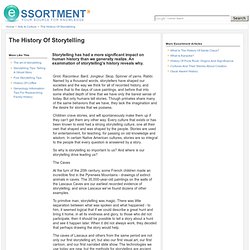
Raconteur. Bard. Jongleur. Skop. Plot (narrative) Plot and Story.

Plot is the cause‐and‐effect sequence of events in a story.[1] Plot is a narrative (and, traditionally, literary) term defined as the events that make up a story, particularly: as they relate to one another in a pattern or in a sequence; as they relate to each other through cause and effect; how the reader views the story; or simply by coincidence. Authors are generally interested in how well this pattern of events accomplishes some artistic or emotional effect. Dramatica Theory of Story Structure. Originated in 1994, the The Dramatica Theory of Story Structure is a diagnostic modelling tool built around a concept called “The Story Mind.” According to this notion, every story has a mind of its own – its psychology is built by the story’s structure and its personality is determined by the storytelling. The theory claims that this model of the mind was developed unintentionally over centuries of storytelling as a by-product of the attempt to communicate information and emotions across a medium from an author to an audience.
In this light a story is seen as an argument in which the author, hoping to convince the audience of a point of view, suggests that a particular approach to problem solving is (or is not) better than all others that might reasonably be tried in a given situation. To successfully make this argument, all other pertinent problem solving approaches must be examined in the story as well and shown to fall short of the one promoted by the author. Dramatic structure. History[edit] Freytag's analysis[edit] "Freytag's pyramid", symbolizing his theory of dramatic structure According to Freytag, a drama is divided into five parts, or acts,[5] which some refer to as a dramatic arc: exposition, rising action, climax, falling action, and dénouement.
Exposition[edit] THE HISTORY OF STORYTELLING! Jacques-Clement Wagrez, French Artist "The Storyteller" Ever since mankind became imaginative, storytellers have been explaining everything people encountered, whether or not it was true. These storytellers are modern humans most influential people. © Donald Louis Hamilton Human Imagination has given mankind the unique ability to communicate abstract concepts and ideas among its people.
It has given its storytellers the power to emotionally enter people's minds. Ever since mankind had evolved a brain capable comprehending abstract ideas, along with an extremely powerful creative imagination, people began to invent words. People have from generation to generation gradually created more complex cultures as they progressed. They connected these vocal sounds into a series of sounds that became crude sentences. People used this crude language to convey everyday deeds and ideas to one another. Storytelling, Storytellers, Stories, Story, Storytelling Techniques, Hear a Story, Read Stories, Audio Stories, Find Tellers, How to Tell A Story - Articles About Storytelling. Good Storytelling and History By: Stanley J. Ward Why study history?
Why bother with stories? The two questions are more closely related than you may think. Narratology. History[edit] Three-act structure. Three- act structure Plot Line Graph by Wendell Wellman. Narreme. Bibliography[edit] Bonheim, Helmut. 2000. "Shakespeare's narremes. " In: Shakespeare Survey 53: Sakespeare and narrative. Edited by Peter Holland. Cambridge: Cambridge University Press, pp. 1-11.[1]Dorfman, Eugène. 1969. Notes[edit] Suspense. Storyboard. The History of Storytelling. Storytellers have shaped our societies and our ways of thinking since before recorded history, back even before the days of cave painting.
Every culture that exists or has been known to exist had a strong storytelling tradition, one all their own that shaped and was shaped by the people who told them, as well as the people who heard them…and told them again. Traditional Storytelling in Africa. Storytelling traditions vary all over the world, yet have many things in common. Storytelling Across the Curriculum. The beginning of the End: Day 3: In Lahore « Architecture and Other HeadAches. Troll Wall Restaurant by Reiulf Ramstad Architects. The jagged glass edges of this restaurant by Norwegian studio Reiulf Ramstad Architects point up towards a sheer cliff face. On Invisible Architecture and Storytelling « Jack Cochran. Por Homme - Men's Lifestyle, Fashion, Footwear and Culture Magazine. Better User Experience With Storytelling – Part 2. Scottish Storytelling Centre, Edinburgh, Photos, Scotland, Storytelling Centre Edinburgh.
INSTRUCTIONS FOR PREPARING PAPERS FOR GA2000. Storytelling in Architecture. Whirlpool aquarium. Whirlpool. How do whirlpools form. Big Site of Amazing Facts © Do whirlpools actually exist and if so, how do they occur? - Yahoo! Answers NZ. Whirlpool - definition of whirlpool by the Free Online Dictionary. What is a Whirlpool? Whirlpools - Water - Extreme Earth - Discovery Channel. Whirlpool"
Getting started. Music Video Awesomeness.